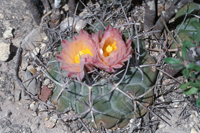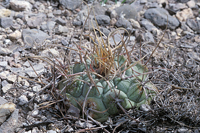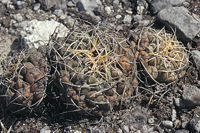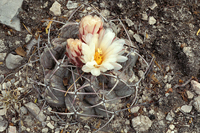Basionym: Echinocactus hexaedrophorus Lemaire, Cact. Gen. Nov. Sp. 27 (1839).
Neotype: Iconographie descriptive des Cactees Plate 2 (1841), E.F. Anderson, Bradleya 5: 69 (1987).
Synonyms: Echinocactus droegeanus Hildm. ex Schumann, Gesambt. Kakt. 438 (1898). Echinocactus hexaedrophorus var. droegeanus R. Meyer, Monatsschr. Kakt.-Kunde 27: 40 (1917). Echinocactus fossulatus Scheidw., Allg. Gartenz. 9: 49 (1841). Echinocactus hexaedrophorus var. fossulatus Salm-Dyck ex Labouret, Monogr. Cact. 251 (1853). Thelocactus fossulatus Br. & R., Cact. 4: 10 (1923). Thelocactus hexaedrophorus var. fossulatus Backeb., Die Cactaceae V: 2800 (1961). Thelomastus hexaedrophorus Frič, in Kreuzinger, Verzeichnis 10 (1935), nom. illeg. Echinocactus hexaedrophorus var. labouretianus Schumann, Gesambt. Kakt. 438 (1898). Thelocactus hexaedrophorus var. labouretianus A. Berger, Kakteen 253 (1929). Echinocactus hexaedrophorus var. major Quehl, Monatsschr. Kakt.-Kunde 4: 29 (1894). Thelocactus hexaedrophorus var. major A. Berger, Kakteen 253 (1929). Thelomastus hexaedrophorus major Frič, in Kreuzinger, Verzeichnis 10 (1935), nom. illeg. Echinocactus hexaedrophorus [var.] roseus Lemaire ex Labouret, Monogr. Cact. 251 (1853). Echinocactus hexaedrophorus [var.] subcostatus Salm-Dyck, Cact. Hort. Dyck. 1849, 34 (1850). Thelocactus hexaedrophorus var. decipiens A. Berger, Kakteen 253 (1929). Thelocactus lloydii Britton & Rose, Cact. 4: 11 (1923). Thelocactus hexaedrophorus var. lloydii (Br. & R.) Kladiwa & Fittkau, in Krainz, Die Kakteen Lfg. 61 (1975). Thelocactus hexaedrophorus ssp. lloydii (Br. & R.) N. P. Taylor, CCI 5: 14 (1998). Thelocactus hexaedrophorus ssp. francii Halda & Sladkovsky, Acta Mus. Richnov. Sect. Nat. 7: 38 (2000). Thelocactus hexaedrophorus ssp. jarmilae Halda & Chvastek, Acta Mus. Richnov. Sect. Nat. 7: 38-39 (2000). Thelocactus hexaedrophorus ssp. kvetae Chvastek & Halda, Acta Mus. Richnov. Sect. Nat. 7: 39 (2000).
Description
Stem single, depressed or globose, 3-7.5 cm tall, 8-15 cm wide. Ribs 8-13, distinct. Tubercles rounded. Areoles elongated into a short groove, without glands. Central spines 0-(1), 15-25 mm long, ochre to reddish, acicular to subulate. Radial spines 4-8, 5-60 mm long, ochre to reddish, straight or curved, acicular to subulate. Flowers 50-100 mm wide, white or pink. Seeds 1.5 x 1.4 mm, testa cells tabular or slightly convex with a verrucose surface sculpture.
Distribution
Mexico, Nuevo León, San Luis Potosí, Tamaulipas, and Zacatecas, occurring in matorral xerofilo and pastizal, on gentle slopes and plains made of limestone or rarely volcanic rocks, at elevations of about 1000 to 2300 metres above sea level. Its range lies within the Meseta Central subregion of the Chihuahuan Desert ecoregion.
Comments
It is the type species of the genus, the second to be imported into Europe and described. The centre of its distribution area is in the state of San Luis Potosí, reaching into Tamaulipas, Nuevo León and Zacatecas. Many local forms are known, often formally described, that differ in stem, spine or flower morphology. Because of the large variability of the species in the whole distribution area, none of these are recognised today. The stem is depressed or globose, with ribs generally evident only in adult plants. The spines, of variable size, are usually strong. The central ones are almost always absent, and when they occur I have never seen more than one. The flowers are white, rarely pinkish. The latter color does not seem to be exclusive, as usually reported, of the populations growing around Rio Verde, San Luis Potosí, that indeed often have white flowers. It may be observed also in other populations, where next to a white flowered plant you can find one with pinkish flowers.
Lloydii was described by Britton and Rose as having eight robust radial spines. Plants coming from La Mancha, Durango, near the northern border of Zacatecas, therefore from an area corresponding to that given in the original description (northern Zacatecas), fit well the description made by Britton and Rose. I think that the identification of this taxon with the plants coming from Fresnillo, Zacatecas, made by Anderson is wrong, because the plants of this population commonly have one central spine, a feature that was not mentioned in the original description of lloydii. Due to the species variability, I think it is not justified to recognise this subspecies, as it has already been done with the other varieties described.
 The neotype of Echinocactus hexaedrophorus Lemaire
The neotype of Echinocactus hexaedrophorus Lemaire Thelocactus hexaedrophorus
Thelocactus hexaedrophorus Thelocactus hexaedrophorus
Thelocactus hexaedrophorus Thelocactus hexaedrophorus
Thelocactus hexaedrophorus Thelocactus hexaedrophorus
Thelocactus hexaedrophorus